traction control MINI Countryman 2012 Owner's Manual
[x] Cancel search | Manufacturer: MINI, Model Year: 2012, Model line: Countryman, Model: MINI Countryman 2012Pages: 201, PDF Size: 3.19 MB
Page 16 of 201
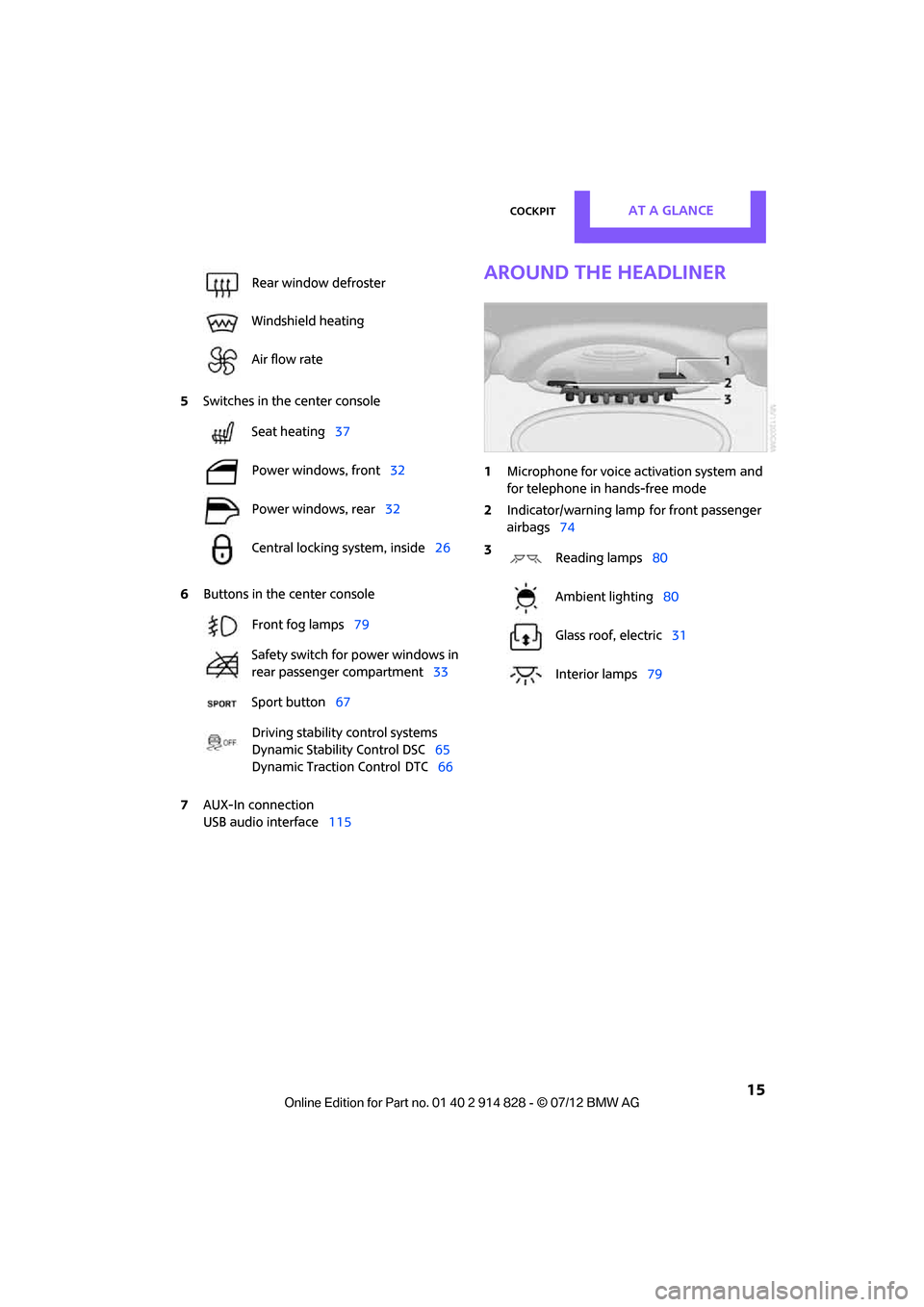
CockpitAT A GLANCE
15
5Switches in the center console
6 Buttons in the center console
7 AUX-In connection
USB audio interface 115
Around the headliner
1Microphone for voice activation system and
for telephone in hands-free mode
2 Indicator/warning lamp
for front passenger
airbags 74
Rear window defroster
Windshield heating
Air flow rate
Seat heating
37
Power windows, front 32
Power windows, rear 32
Central locking system, inside 26
Front fog lamps 79
Safety switch for power windows in
rear passenger compartment 33
Sport button 67
Driving stability control systems
Dynamic Stability Control DSC 65
Dynamic Traction Control
DTC 66
3
Reading lamps 80
Ambient lighting 80
Glass roof, electric 31
Interior lamps 79
Online Edition for Part no. 01 40 2 914 828 - \251 07/12 BMW AG
Page 48 of 201
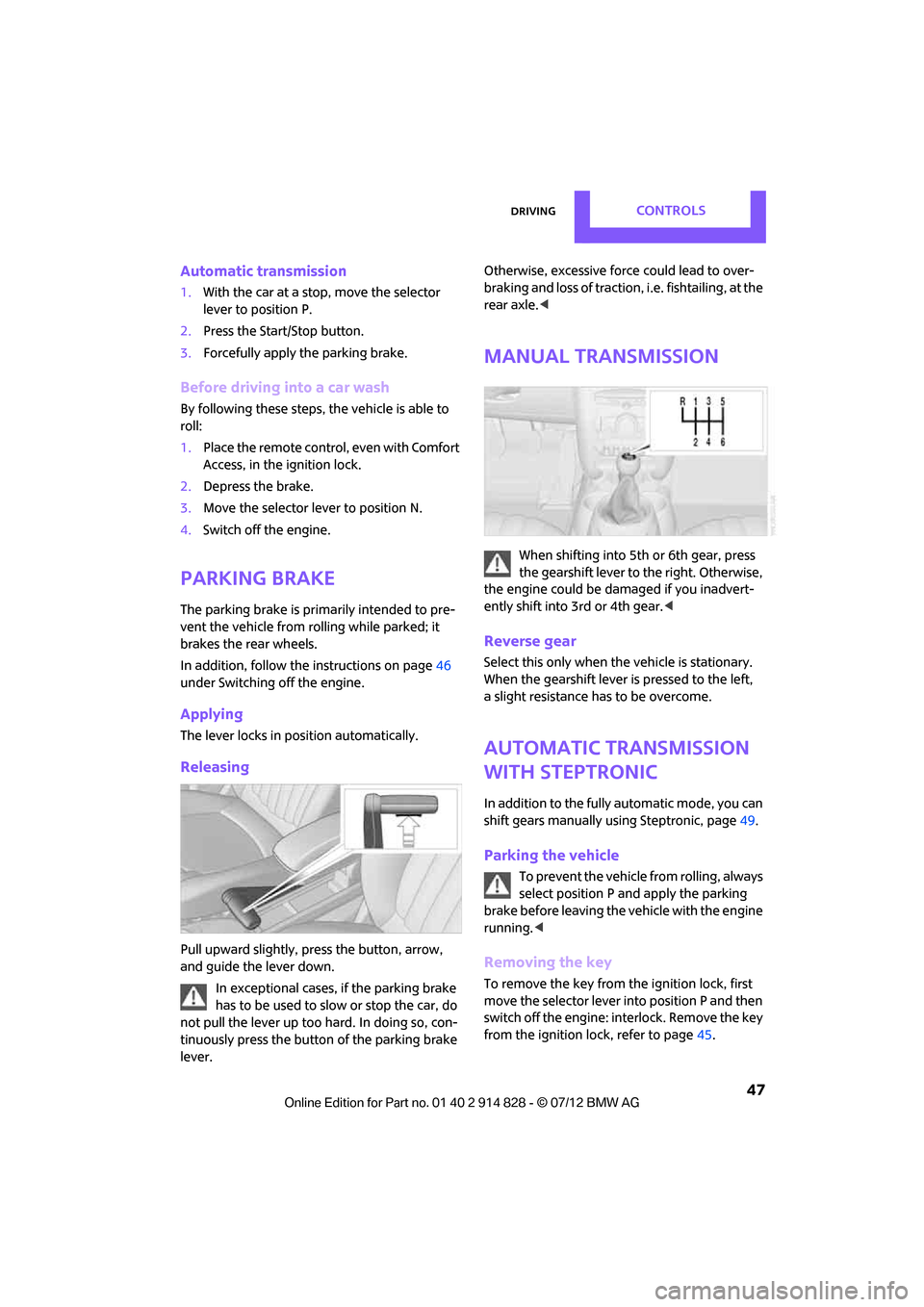
DrivingCONTROLS
47
Automatic transmission
1.With the car at a stop, move the selector
lever to position P.
2. Press the Start/Stop button.
3. Forcefully apply the parking brake.
Before driving into a car wash
By following these steps, the vehicle is able to
roll:
1.Place the remote control, even with Comfort
Access, in the ig nition lock.
2. Depress the brake.
3. Move the selector lever to position N.
4. Switch off the engine.
Parking brake
The parking brake is primarily intended to pre-
vent the vehicle from rolling while parked; it
brakes the rear wheels.
In addition, follow the instructions on page 46
under Switching off the engine.
Applying
The lever locks in position automatically.
Releasing
Pull upward slightly, press the button, arrow,
and guide the lever down.
In exceptional cases, if the parking brake
has to be used to slow or stop the car, do
not pull the lever up too hard. In doing so, con-
tinuously press the button of the parking brake
lever. Otherwise, excessive force could lead to over-
braking and loss of traction, i.e. fishtailing, at the
rear axle.
<
Manual transmission
When shifting into 5th or 6th gear, press
the gearshift lever to the right. Otherwise,
the engine could be damaged if you inadvert-
ently shift into 3rd or 4th gear.<
Reverse gear
Select this only when the vehicle is stationary.
When the gearshift lever is pressed to the left,
a slight resistance has to be overcome.
Automatic transmission
with Steptronic
In addition to the fully automatic mode, you can
shift gears manually using Steptronic, page 49.
Parking the vehicle
To prevent the vehicle from rolling, always
select position P and apply the parking
brake before leaving the vehicle with the engine
running. <
Removing the key
To remove the key from the ignition lock, first
move the selector lever into position P and then
switch off the engine: interlock. Remove the key
from the ignition lock, refer to page 45.
Online Edition for Part no. 01 40 2 914 828 - \251 07/12 BMW AG
Page 66 of 201

Technology for driving comfort and safetyCONTROLS
65
property damage. Loud sound sources outside
or inside the car can drown out the PDC signal.<
Driving stability control
systems
Your MINI has a number of systems that help to
maintain the vehicle's st ability even in adverse
driving conditions.
The laws of physics cannot be repealed,
even with driving stability control systems.
An appropriate driving style always remains the
responsibility of the driver. Therefore do not
reduce the additional safety margin by engaging
in hazardous driving thereby running the risk of
an accident. <
Antilock Brake System ABS
ABS prevents locking of the wheels during brak-
ing. Safe steering respon se is maintained even
during full braking. Act ive safety is thus
increased.
Braking safely, refer to page 97.
ABS is operational every time you start the
engine.
Cornering Brake Control CBC
Driving stability and steering characteristics are
further enhanced while braking in turns or dur-
ing a lane change.
Electronic brake-forc e distribution EBV
The system controls the brake pressure in the
rear wheels to ensure stable braking behavior.
Brake Assist
Rapidly depressing the brake causes this system
to automatically develop maximum braking
force. Thus, the system helps keep braking dis-
tance to a minimum. At the same time, all the
benefits provided by ABS are exploited.
Do not reduce the pressure on the brake for the
duration of the full braking application.
Dynamic Stability Control DSC
The concept
DSC prevents the driving wheels from losing
traction when you pull away from rest or accel-
erate.
DSC also detects unstable driving conditions
such as when the vehicle' s rear end fishtails or
the vehicle is sliding on its front wheels. In these
cases, DSC helps the vehicle maintain a safe
course within physical limits by reducing engine
output and through brakin g actions at the indi-
vidual wheels.
Every time that the engine is started, DSC is
ready to operate.
Deactivating DSC
Press the button until the DSC OFF indicator
lamp on the speedometer is on and DSC OFF is
displayed on the tachometer. DSC is deacti-
vated. Stabilizing and propulsion promoting
actions are no longer executed.
When driving with snow chains or to 'rock free'
in snow, it can be helpful to switch off DSC for
a brief period.
To increase vehicle stability, activate DSC again
as soon as possible.
Activating DSC
Press the button again: the DSC indicator lamps
in the display elements go out.
Online Edition for Part no. 01 40 2 914 828 - \251 07/12 BMW AG
Page 67 of 201

CONTROLSTechnology for driving comfort and safety
66
For better control
The indicator lamp on the tachometer is
flashing:
DSC controls the driving and braking
forces.
The indicator lamp DSC OFF on the
speedometer is on and DSC OFF is
displayed on the tachometer:
DSC is deactivated.
Dynamic Traction Control DTC
The concept
DTC is a type of DSC that is propulsion optimized
for special road conditions such as uncleared
snowy roads. The syst em ensures maximum
propulsion though with restricted driving stabil-
ity. You therefore need to drive with suitable
caution.
In the following exceptiona l situations, it can be
useful to briefly activate DTC:
> When driving on snow-c overed inclines, in
slush, or on uncleared snowy roads
> When rocking the vehicle free, driving out of
deep snow or on loose surfaces
> When driving with snow chains
Activating DTC
Press the button; the indicator lamp DSC OFF on
the speedometer comes on and TRACTION is
displayed on the tachometer.
The Dynamic Stability Control DSC is deacti-
vated; the Dynamic Traction Control DTC is
activated.
For better control
The indicator lamp on the tachometer is
flashing:
DTC controls the driving and braking
forces.
The indicator lamp on the speedometer
is on and TRACTION is displayed on the
tachometer:
DTC is activated.
Deactivating DTC
Press button again, the indicator lamp DSC OFF
on the speedometer and TRACTION on the
tachometer go out.
Online Edition for Part no. 01 40 2 914 828 - \251 07/12 BMW AG
Page 68 of 201
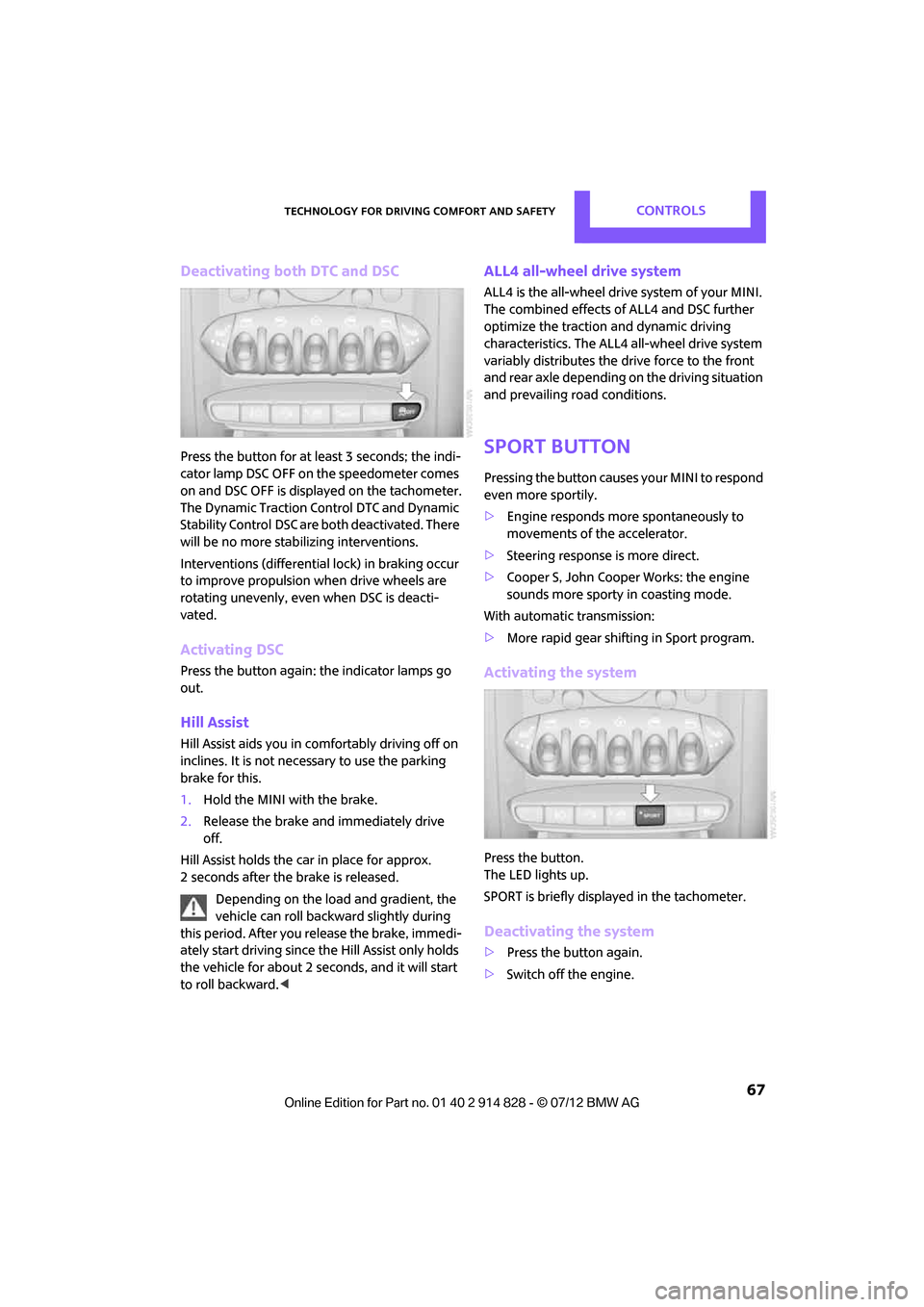
Technology for driving comfort and safetyCONTROLS
67
Deactivating both DTC and DSC
Press the button for at least 3 seconds; the indi-
cator lamp DSC OFF on the speedometer comes
on and DSC OFF is displayed on the tachometer.
The Dynamic Traction Control DTC and Dynamic
Stability Control DSC are both deactivated. There
will be no more stab ilizing interventions.
Interventions (differentia l lock) in braking occur
to improve propulsion when drive wheels are
rotating unevenly, even when DSC is deacti-
vated.
Activating DSC
Press the button again: the indicator lamps go
out.
Hill Assist
Hill Assist aids you in co mfortably driving off on
inclines. It is not necessary to use the parking
brake for this.
1. Hold the MINI with the brake.
2. Release the brake and immediately drive
off.
Hill Assist holds the car in place for approx.
2 seconds after the brake is released. Depending on the load and gradient, the
vehicle can roll backwa rd slightly during
this period. After you release the brake, immedi-
ately start driving since the Hill Assist only holds
the vehicle for about 2 seconds, and it will start
to roll backward. <
ALL4 all-wheel drive system
ALL4 is the all-wheel drive system of your MINI.
The combined effects of ALL4 and DSC further
optimize the traction and dynamic driving
characteristics. The ALL4 all-wheel drive system
variably distributes the drive force to the front
and rear axle depending on the driving situation
and prevailing road conditions.
Sport button
Pressing the button causes your MINI to respond
even more sportily.
> Engine responds more spontaneously to
movements of the accelerator.
> Steering response is more direct.
> Cooper S, John Cooper Works: the engine
sounds more sporty in coasting mode.
With automatic transmission:
> More rapid gear shifting in Sport program.
Activating the system
Press the button.
The LED lights up.
SPORT is briefly displayed in the tachometer.
Deactivating the system
>Press the button again.
> Switch off the engine.
Online Edition for Part no. 01 40 2 914 828 - \251 07/12 BMW AG
Page 106 of 201
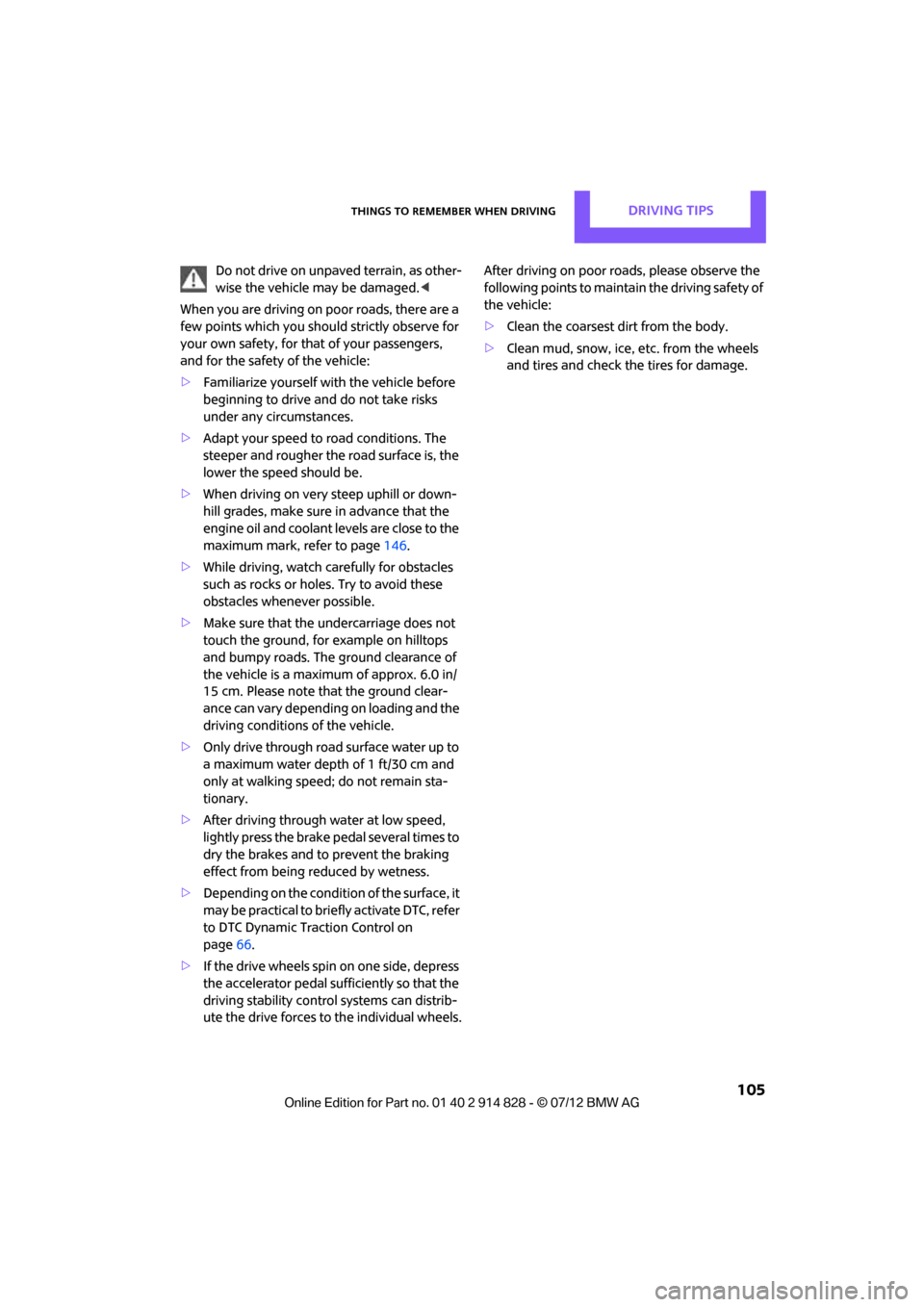
Things to remember when drivingDRIVING TIPS
105
Do not drive on unpaved terrain, as other-
wise the vehicle may be damaged.<
When you are driving on poor roads, there are a
few points which you shou ld strictly observe for
your own safety, for that of your passengers,
and for the safety of the vehicle:
> Familiarize yourself with the vehicle before
beginning to drive an d do not take risks
under any circumstances.
> Adapt your speed to road conditions. The
steeper and rougher the road surface is, the
lower the speed should be.
> When driving on very steep uphill or down-
hill grades, make sure in advance that the
engine oil and coolant levels are close to the
maximum mark, refer to page 146.
> While driving, watch carefully for obstacles
such as rocks or holes. Try to avoid these
obstacles whenever possible.
> Make sure that the un dercarriage does not
touch the ground, for example on hilltops
and bumpy roads. The ground clearance of
the vehicle is a maximum of approx. 6.0 in/
15 cm. Please note that the ground clear-
ance can vary depending on loading and the
driving conditions of the vehicle.
> Only drive through road surface water up to
a maximum water depth of 1 ft/30 cm and
only at walking speed; do not remain sta-
tionary.
> After driving through water at low speed,
lightly press the brake pedal several times to
dry the brakes and to prevent the braking
effect from being reduced by wetness.
> Depending on the condition of the surface, it
may be practical to briefly activate DTC, refer
to DTC Dynamic Traction Control on
page 66.
> If the drive wheels spin on one side, depress
the accelerator pedal sufficiently so that the
driving stability control systems can distrib-
ute the drive forces to the individual wheels. After driving on poor roads, please observe the
following points to maintain the driving safety of
the vehicle:
>
Clean the coarsest dirt from the body.
> Clean mud, snow, ice, etc. from the wheels
and tires and check the tires for damage.
Online Edition for Part no. 01 40 2 914 828 - \251 07/12 BMW AG
Page 142 of 201
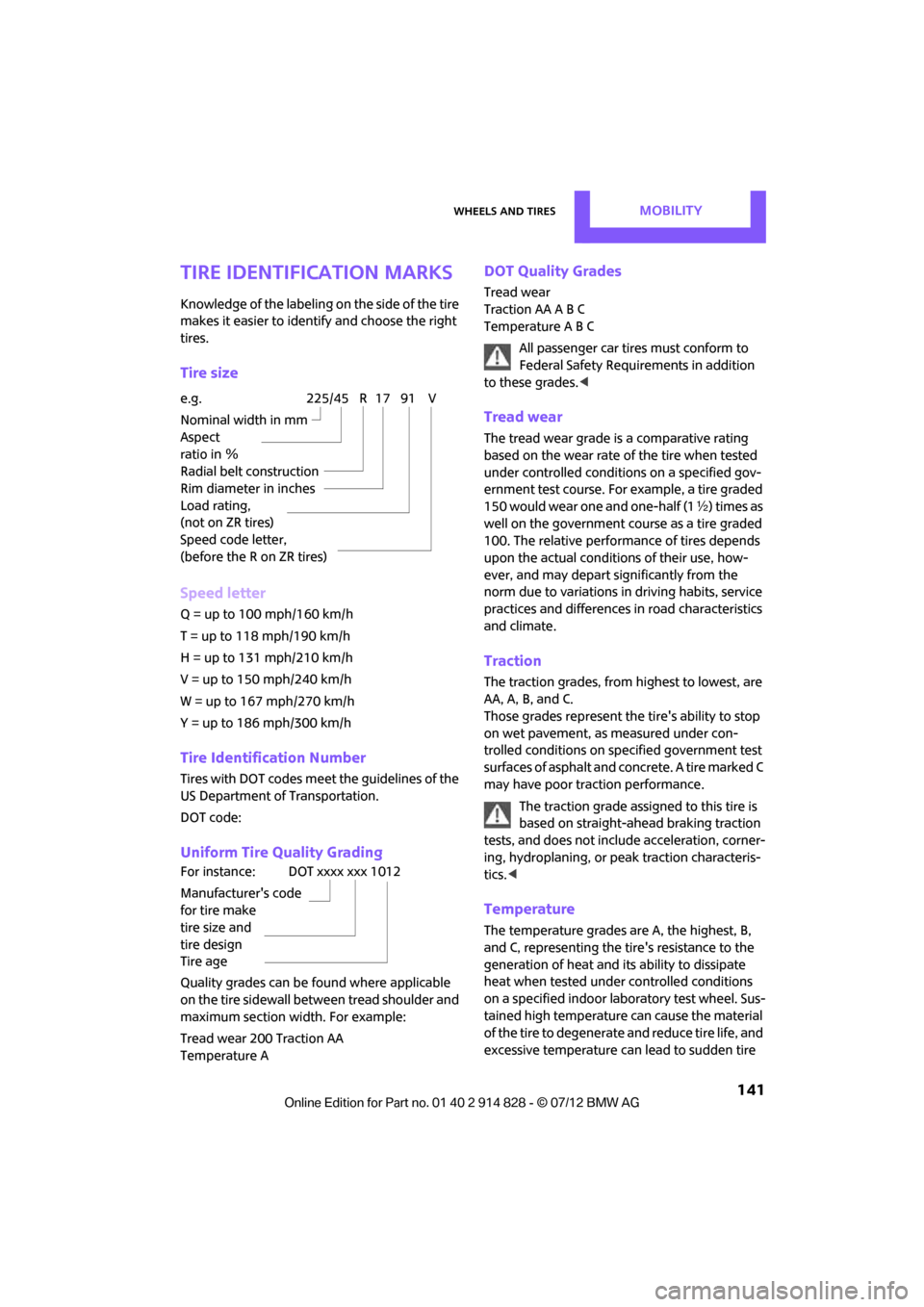
Wheels and tiresMOBILITY
141
Tire identification marks
Knowledge of the labeling on the side of the tire
makes it easier to identify and choose the right
tires.
Tire size
Speed letter
Q = up to 100 mph/160 km/h
T = up to 118 mph/190 km/h
H = up to 131 mph/210 km/h
V = up to 150 mph/240 km/h
W = up to 167 mph/270 km/h
Y = up to 186 mph/300 km/h
Tire Identification Number
Tires with DOT codes meet the guidelines of the
US Department of Transportation.
DOT code:
Uniform Tire Quality Grading
Quality grades can be found where applicable
on the tire sidewall between tread shoulder and
maximum section width. For example:
Tread wear 200 Traction AA
Temperature A
DOT Quality Grades
Tread wear
Traction AA A B C
Temperature A B C
All passenger car tires must conform to
Federal Safety Requirements in addition
to these grades. <
Tread wear
The tread wear grade is a comparative rating
based on the wear rate of the tire when tested
under controlled conditions on a specified gov-
ernment test course. For example, a tire graded
150 would wear one and one-half (1 γ) times as
well on the government course as a tire graded
100. The relative performance of tires depends
upon the actual conditions of their use, how-
ever, and may depart si gnificantly from the
norm due to variations in driving habits, service
practices and differences in road characteristics
and climate.
Traction
The traction grades, from highest to lowest, are
AA, A, B, and C.
Those grades represent the tire's ability to stop
on wet pavement, as measured under con-
trolled conditions on specified government test
surfaces of asphalt and concrete. A tire marked C
may have poor traction performance.
The traction grade assigned to this tire is
based on straight-ahead braking traction
tests, and does not incl ude acceleration, corner-
ing, hydroplaning, or peak traction characteris-
tics. <
Temperature
The temperature grades are A, the highest, B,
and C, representing the tire's resistance to the
generation of heat and its ability to dissipate
heat when tested under controlled conditions
on a specified indoor labo ratory test wheel. Sus-
tained high temperature can cause the material
of the tire to degenerate and reduce tire life, and
excessive temperature can lead to sudden tire
e.g.
Nominal width in mm
Aspect
ratio in Ξ
Radial belt construction
Rim diameter in inches
Load rating,
(not on ZR tires)
Speed code letter,
(before the R on ZR tires)
225/45 R 17 91 V
For instance:
Manufacturer's code
for tire make
tire size and
tire design
Tire ageDOT xxxx xxx 1012
Online Edition for Part no. 01 40 2 914 828 - \251 07/12 BMW AG
Page 176 of 201

Indicator and warning lampsMOBILITY
175
Flashing:
Dynamic Stability Control DSC or
Dynamic Traction Control DTC is con-
trolling drive and braking forces, refer
also to page65
Dynamic Traction Control DTC is acti-
vated, refer also to page 66
The Dynamic Stability Control DSC
and Dynamic Traction Control DTC
are deactivated, refer also to page 65Driving stability limited during
acceleration and cornering.
Driving style must
be adjusted.
The Dynamic Stability Control DSC
and Dynamic Traction Control DTC
have failed. Driving stability limited during
acceleration and cornering.
You can continue your journey, but
moderate your speed and exercise
due caution. Have the system
checked as soon as possible.
Indication in US models
The driving stabili ty control systems,
including ABS and the Tire Pressure
Monitor, have failed, refer also to
page 65 Reduced braking and driving stability.
Drive cautiously and think well ahead.
Avoid braking with full force, driving
on rough tracks, and depressing the
accelerator pedal to full throttle or
kickdown position. Have the system
checked immediately.
Indication in US models
The driving stabili ty control systems,
including ABS, ALL4 all-wheel drive,
and the Tire Pressu re Monitor, have
failed, refer also to page 65Reduced braking and driving stability.
Drive cautiously and think well ahead.
Avoid braking with full force, driving
on rough tracks, and depressing the
accelerator pedal to full throttle or
kickdown position. Have the system
checked immediately.
12Cause What to do
Online Edition for Part no. 01 40 2 914 828 - \251 07/12 BMW AG
Page 192 of 201
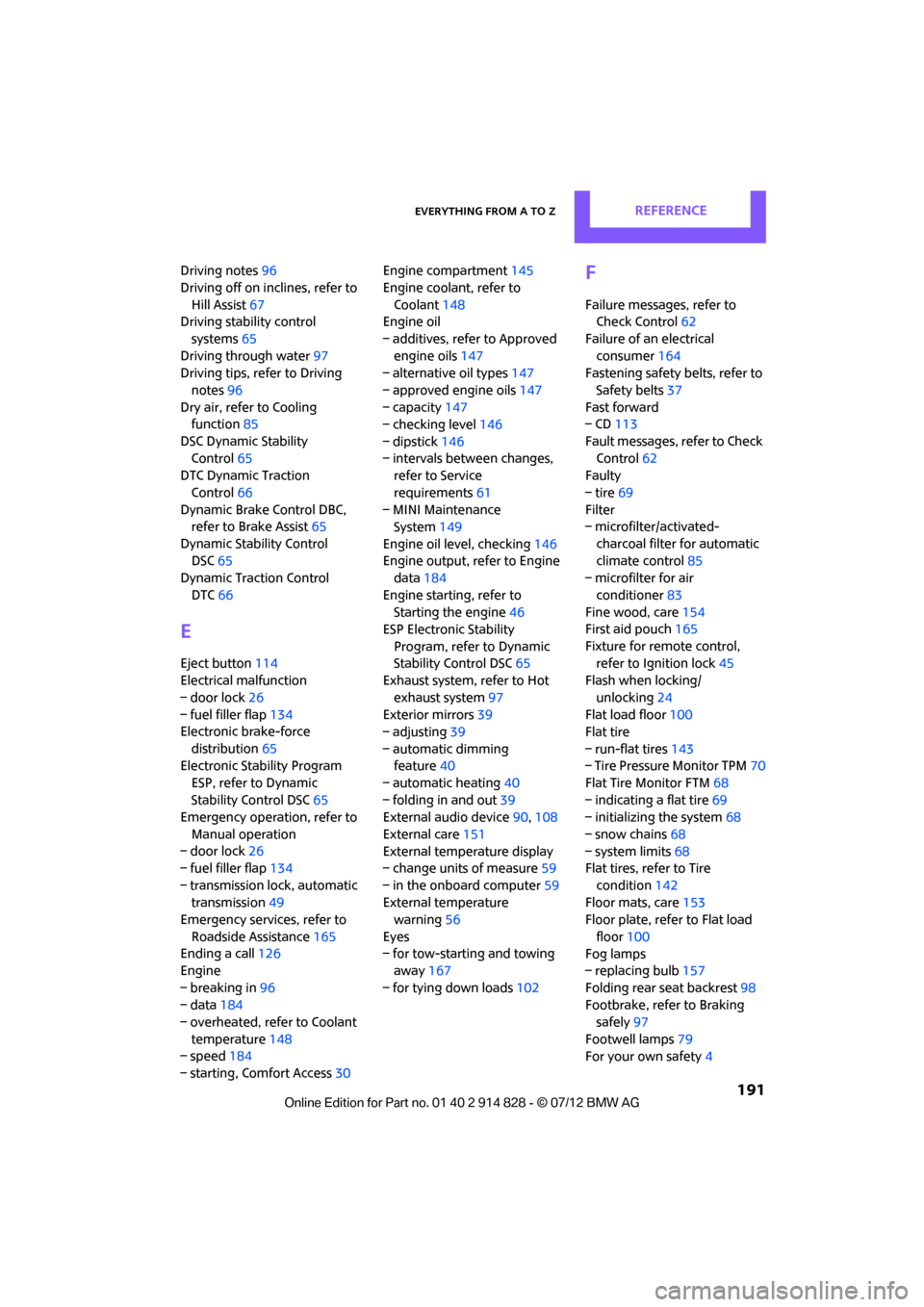
Everything from A to ZREFERENCE
191
Driving notes96
Driving off on inclines, refer to Hill Assist 67
Driving stability control
systems 65
Driving through water 97
Driving tips, refer to Driving
notes 96
Dry air, refer to Cooling function 85
DSC Dynamic Stability Control 65
DTC Dynamic Traction
Control 66
Dynamic Brake Control DBC, refer to Brake Assist 65
Dynamic Stability Control DSC 65
Dynamic Traction Control
DTC 66
E
Eject button 114
Electrical malfunction
– door lock 26
– fuel filler flap 134
Electronic brake-force
distribution 65
Electronic Stability Program
ESP, refer to Dynamic
Stability Control DSC 65
Emergency operation, refer to
Manual operation
– door lock 26
– fuel filler flap 134
– transmission lock, automatic transmission 49
Emergency services, refer to
Roadside Assistance 165
Ending a call 126
Engine
– breaking in 96
– data 184
– overheated, refer to Coolant
temperature 148
– speed 184
– starting, Comfort Access 30Engine compartment
145
Engine coolant, refer to Coolant 148
Engine oil
– additives, refer to Approved engine oils 147
– alternative oil types 147
– approved engine oils 147
– capacity 147
– checking level 146
– dipstick 146
– intervals between changes, refer to Service
requirements 61
– MINI Maintenance System 149
Engine oil level, checking 146
Engine output, refer to Engine data 184
Engine starting, refer to Starting the engine 46
ESP Electronic Stability
Program, refer to Dynamic
Stability Control DSC 65
Exhaust system, refer to Hot
exhaust system 97
Exterior mirrors 39
– adjusting 39
– automatic dimming feature 40
– automatic heating 40
– folding in and out 39
External audio device 90,108
External care 151
External temperature display
– change units of measure 59
– in the onboard computer 59
External tem peratur
e
warning 56
Eyes
– for tow-starting and towing away 167
– for tying down loads 102
F
Failure messages, refer to
Check Control 62
Failure of an electrical consumer 164
Fastening safety be lts, refer to
Safety belts 37
Fast forward
– CD 113
Fault messages, refer to Check
Control 62
Faulty
– tire 69
Filter
– microfilter/activated-
charcoal filter for automatic
climate control 85
– microfilter for air
conditioner 83
Fine wood, care 154
First aid pouch 165
Fixture for remote control, refer to Ignition lock 45
Flash when locking/
unlocking 24
Flat load floor 100
Flat tire
– run-flat tires 143
– Tire Pressure Monitor TPM 70
Flat Tire Monitor FTM 68
– indicating a flat tire 69
– initializing the system 68
– snow chains 68
– system limits 68
Flat tires, refer to Tire
condition 142
Floor mats, care 153
Floor plate, refe r to Flat load
floor 100
Fog lamps
– replacing bulb 157
Folding rear seat backrest 98
Footbrake, refer to Braking safely 97
Footwell lamps 79
For your own safety 4
Online Edition for Part no. 01 40 2 914 828 - \251 07/12 BMW AG
Page 199 of 201
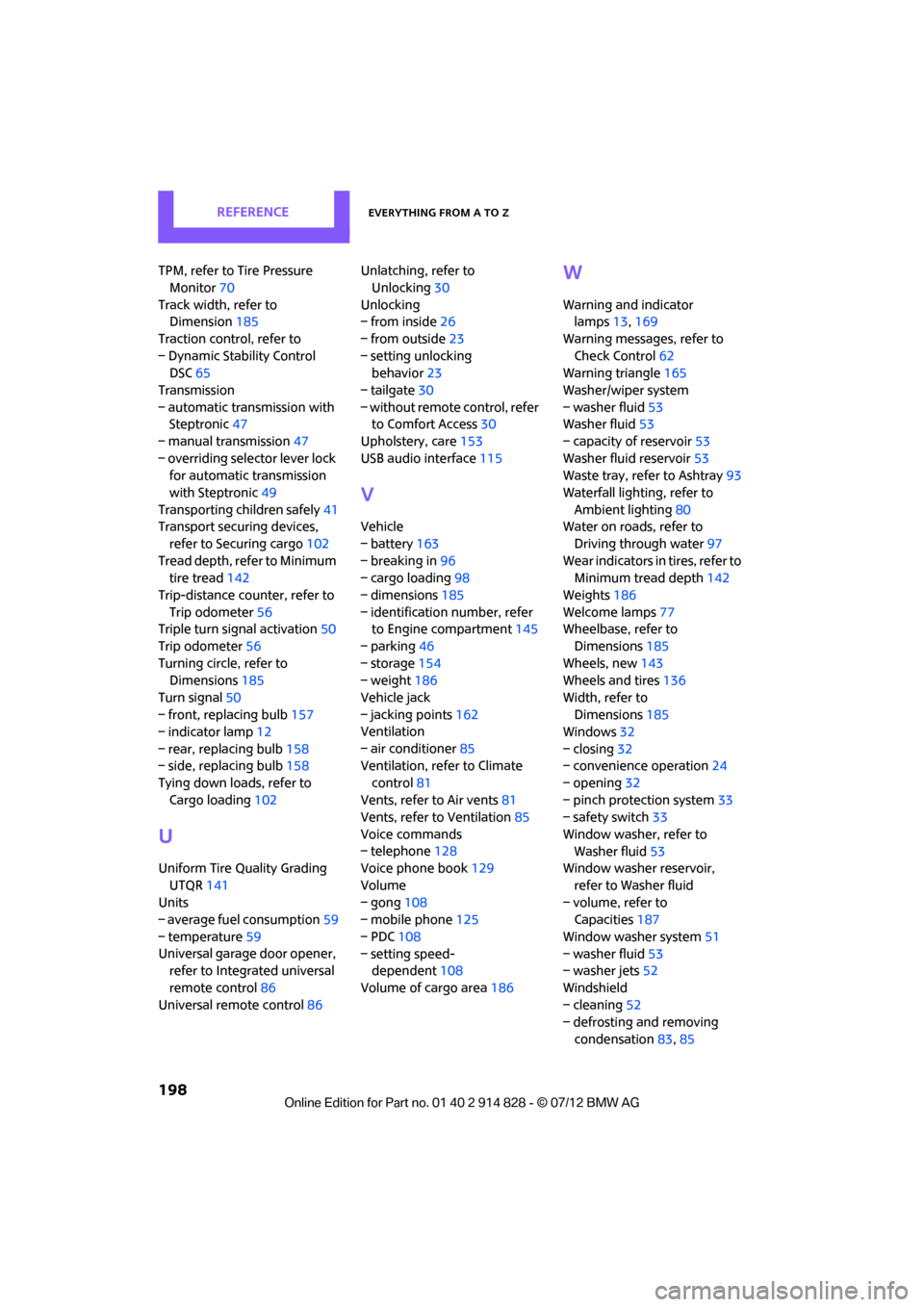
REFERENCEEverything from A to Z
198
TPM, refer to Tire Pressure Monitor 70
Track width, refer to Dimension 185
Traction control, refer to
– Dynamic Stability Control DSC 65
Transmission
– automatic transmission with Steptronic 47
– manual transmission 47
– overriding selector lever lock for automatic transmission
with Steptronic 49
Transporting children safely 41
Transport securing devices,
refer to Securing cargo 102
Tread depth, refer to Minimum tire tread 142
Trip-distance counter, refer to Trip odometer 56
Triple turn si gnal activation 50
Trip odometer 56
Turning circle, refer to Dimensions 185
Turn signal 50
– front, replacing bulb 157
– indicator lamp 12
– rear, replacing bulb 158
– side, replacing bulb 158
Tying down load s, refer to
Cargo loading 102
U
Uniform Tire Quality Grading
UTQR 141
Units
– average fuel consumption 59
– temperature 59
Universal garage door opener, refer to Integrated universal
remote control 86
Universal remote control 86Unlatching, refer to
Unlocking 30
Unlocking
– from inside 26
– from outside 23
– setting unlocking behavior 23
– tailgate 30
– without remote control, refer
to Comfort Access 30
Upholstery, care 153
USB audio interface 115
V
Vehicle
– battery163
– breaking in 96
– cargo loading 98
– dimensions 185
– identification number, refer to Engine compartment 145
– parking 46
– storage 154
– weight 186
Vehicle jack
– jacking points 162
Ventilation
– air conditioner 85
Ventilation, refer to Climate
control 81
Vents, refer to Air vents 81
Vents, refer to Ventilation 85
Voice commands
– telephone 128
Voice phone book 129
Volume
– gong 108
– mobile phone 125
– PDC 108
– setting speed- dependent 108
Volume of cargo area 186
W
Warning and indicator
lamps 13,169
Warning messages, refer to Check Control 62
Warning triangle 165
Washer/wiper system
– washer fluid 53
Washer fluid 53
– capacity of reservoir 53
Washer fluid reservoir 53
Waste tray, refer to Ashtray 93
Waterfall lighti ng, refer to
Ambient lighting 80
Water on roads, refer to
Driving through water 97
Wear indicators in tires, refer to Minimum tread depth 142
Weights 186
Welcome lamps 77
Wheelbase, refer to
Dimensions 185
Wheels, new 143
Wheels and tires 136
Width, refer to Dimensions 185
Windows 32
– closing 32
– convenience operation 24
– opening 32
– pinch protection system 33
– safety switch 33
Window washer, refer to Washer fluid 53
Window washer reservoir,
refer to Washer fluid
– volume, refer to Capacities 187
Window washer system 51
– washer fluid 53
– washer jets 52
Windshield
– cleaning 52
– defrosting and removing
condensation 83,85
Online Edition for Part no. 01 40 2 914 828 - \251 07/12 BMW AG